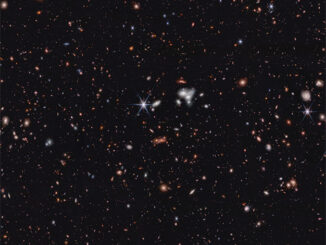
Astronomers have found the most distant quasar yet discovered, a powerhouse seen shining just 670 million years after the Big Bang. The quasar’s supermassive black hole, some 1.6 billion times as massive as the Sun, is the youngest on record, posing a challenge to theorists trying to explain how black holes could have grown so massive so early in cosmic history.
“Black holes created by the very first massive stars could not have grown this large in only a few hundred million years,” said Feige Wang, a NASA Hubble fellow at the University of Arizona and lead author of a paper on the discovery accepted by The Astrophysical Journal Letters.
One theory about early black hole evolution holds that massive first-generation consisting mostly of hydrogen explode in supernova blasts, leaving behind already massive black holes that consume surrounding material and growing rapidly in the process. Another model suggest supermassive black holes can be formed when dense star clusters collapse, directly forming a massive black hole.
But the newly discovered quasar, known as J0313-1806, features a black hole that’s too young and too massive to be explained by earlier theories. Wang and his colleagues calculated that if the quasar’s black hole formed as early as 100 million years after the Big Bang and then grew as fast as possible, it would have had to start out with a mass of 10,000 suns to reach its current size.
“This tells you that no matter what you do, the seed of this black hole must have formed by a different mechanism,” said co-author Xiaohui Fan, Regents Professor and associate head of the University of Arizona Department of Astronomy. “In this case, one that involves vast quantities of primordial, cold hydrogen gas directly collapsing into a seed black hole.”
Because that mechanism does not require mature stars for raw material, team members say it’s the only model that can explain a 1.6-billion-solar-mass black hole when the universe was just 5 percent of its current age.
“Once you go to lower redshifts, all the models could explain the existence of those less distant and less massive quasars,” Fan said. “In order for the black hole to have grown to the size we see with J0313-1806, it would have to have started out with a seed black hole of at least 10,000 solar masses, and that would only be possible in the direct collapse scenario.”



